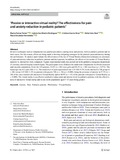Mostrar el registro sencillo del ítem
Passive or interactive virtual reality? The effectiveness for pain and anxiety reduction in pediatric patients
| dc.creator | Ferraz Torres, Marta | es_ES |
| dc.creator | San Martín Rodríguez, Leticia | es_ES |
| dc.creator | García Vivar, Cristina | es_ES |
| dc.creator | Soto Ruiz, María Nelia | es_ES |
| dc.creator | Escalada Hernández, Paula | es_ES |
| dc.date.accessioned | 2022-08-04T07:46:04Z | |
| dc.date.available | 2022-08-04T07:46:04Z | |
| dc.date.issued | 2022 | |
| dc.identifier.citation | Ferraz-Torres, M., San Martín-Rodríguez, L., García-Vivar, C., Soto-Ruiz, N., Escalada-Hernández, P.. (2022). Passive or interactive virtual reality? The effectiveness for pain and anxiety reduction in pediatric patients. Virtual Reality. 1-10 . | en |
| dc.identifier.issn | 1359-4338 | |
| dc.identifier.uri | https://hdl.handle.net/2454/43692 | |
| dc.description.abstract | Invasive techniques such as venipuncture are painful procedures causing stress and anxiety, both in pediatric patients and in their carers. For this reason, efforts are being made to develop mitigating strategies for the patient's pain and anxiety during the performance. To analyze and evaluate the effectiveness of the use of Virtual Reality distraction techniques as a measure of pain and anxiety reduction in pediatric patients and their parents. In addition, the effects of two modes of Virtual Reality (passive vs. interactive) were compared. A quasi-experimental study was carried out in the pediatric emergency department of a tertiary referral hospital in north Spain. The participants were children who underwent venipuncture for blood extraction and vascular cannulation. From the 124 patients, 51.6% (n = 64) were girls and 48.4% (n = 60) were boys (p = 0.574). The mean age was 8.4 years (SD: 4.1). The mean level of pain experienced was 2.33 (SD: 0.76) in the interactive VR group (n = 88) versus 2.67 (SD: 1.35) in patients with passive VR (n = 36) (p = 0.008); being the presence of anxiety in 27.3% (n = 24) of the cases treated with interactive Virtual Reality and in 88.9% (n = 32) of the patients with passive Virtual Reality (p = 0.000). The virtual reality is an effective method to reduce pain and anxiety levels in pediatric patients, with the effectiveness of interactive virtual reality and its use in the population aged 7-15 years being greater. | en |
| dc.description.sponsorship | Open Access funding provided thanks to the CRUE-CSIC agreement with Springer Nature. This research is part of the ReVi project, funded by the 'Precipita' crowdfunding platform, from the Spanish Foundation for Science and Technology (FECYT). | en |
| dc.format.mimetype | application/pdf | en |
| dc.language.iso | eng | en |
| dc.publisher | Springer | en |
| dc.relation.ispartof | Virtual Reality, 2022 | en |
| dc.rights | This article is licensed under a Creative Commons Attribution 4.0 International License | en |
| dc.rights.uri | http://creativecommons.org/licenses/by/4.0/ | |
| dc.subject | Anxiety | en |
| dc.subject | Pain | en |
| dc.subject | Pediatric patients | en |
| dc.subject | Phlebotomy | en |
| dc.subject | Virtual Reality | en |
| dc.title | Passive or interactive virtual reality? The effectiveness for pain and anxiety reduction in pediatric patients | en |
| dc.type | Artículo / Artikulua | es |
| dc.type | info:eu-repo/semantics/article | en |
| dc.date.updated | 2022-08-04T07:23:37Z | |
| dc.contributor.department | Ciencias de la Salud | es_ES |
| dc.contributor.department | Osasun Zientziak | eu |
| dc.rights.accessRights | Acceso abierto / Sarbide irekia | es |
| dc.rights.accessRights | info:eu-repo/semantics/openAccess | en |
| dc.identifier.doi | 10.1007/s10055-022-00633-7 | |
| dc.relation.publisherversion | https://doi.org/10.1007/s10055-022-00633-7 | |
| dc.type.version | Versión publicada / Argitaratu den bertsioa | es |
| dc.type.version | info:eu-repo/semantics/publishedVersion | en |



